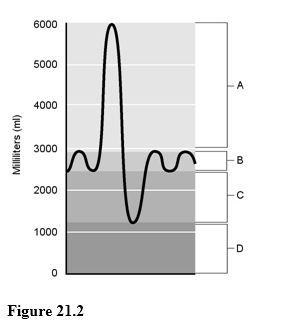Which artery supplies blood to the brachium?
A) axillary artery
B) esophageal arteries
C) subscapular artery
D) costocervical artery
A
Explanation:
B) The esophageal arteries, several small vessels of varying origin along the thoracic aorta, supply blood to the esophagus.
C) The subscapular artery supplies blood to the dorsal shoulder muscles.
D) Each costocervical artery sends branches to the deep muscles of the neck and shoulder and to the first two costal interspaces.
You might also like to view...
Using Figure 21.2, match the following:

1) Tidal volume.
2) Inspiratory reserve volume.
3) Residual volume.
4) Expiratory reserve volume.
5) Air that does not participate in the exchange of gases.
Which of the following is NOT a bodily function controlled by nerve impulses?
A. Problem solving and other higher mental functions B. Responses to various stimuli C. Generation of thought processes D. Muscle contraction E. All of these are functions controlled by nerve impulses.
Voltage-gated channels are present
A) at the motor end plate. B) on the surface of dendrites. C) in the membrane that covers axons. D) on the soma of neurons. E) along the perikaryon of neurons.
Beaker 1 contains water at 23 degrees C. Beaker 2 contains water at 5 degrees C. Beaker 3 contains water at 95 degrees C. In which beaker will the rate of diffusion be greatest?
A) beaker 3 B) beaker 2 C) beaker 1 D) There is not enough information given to answer the question.